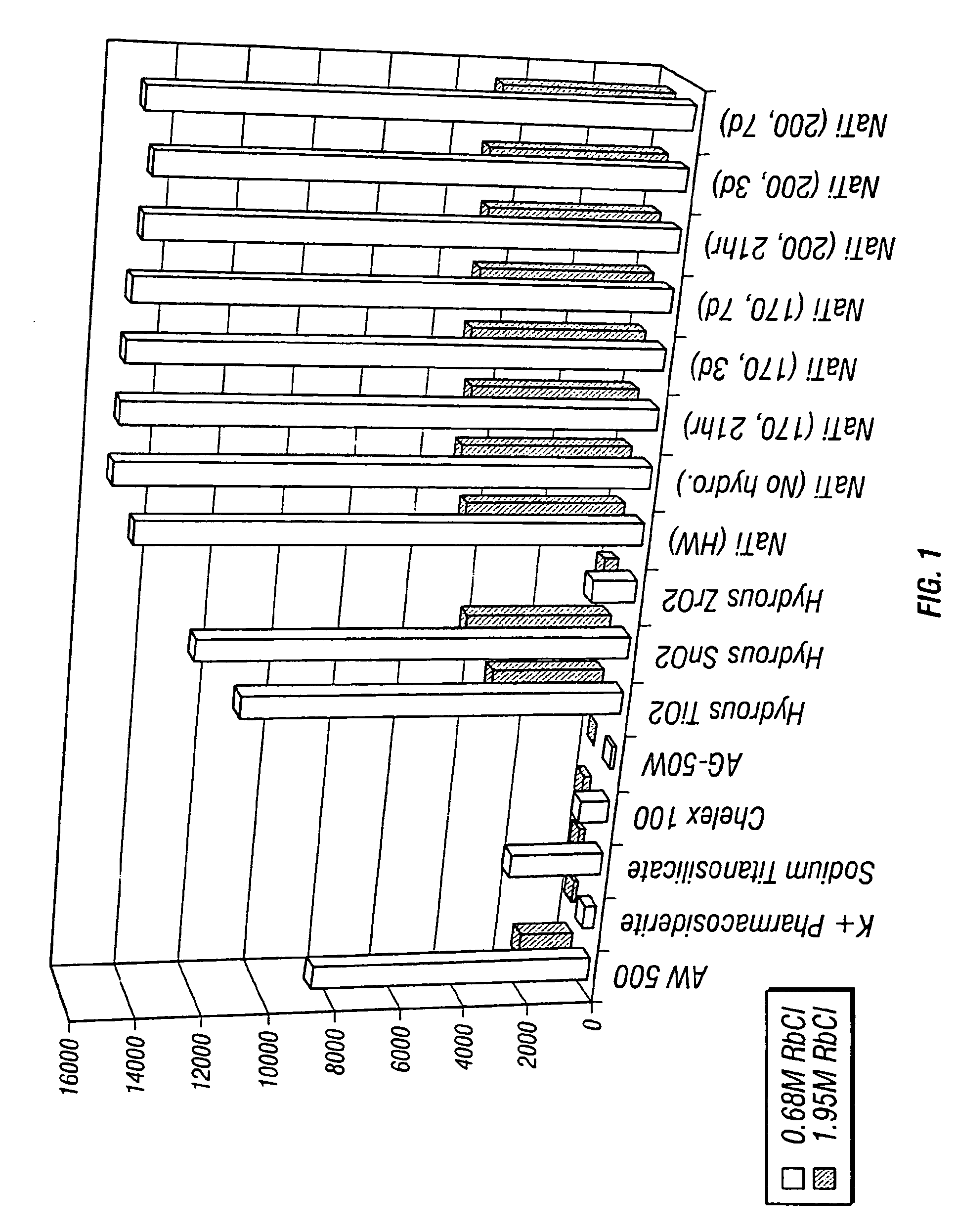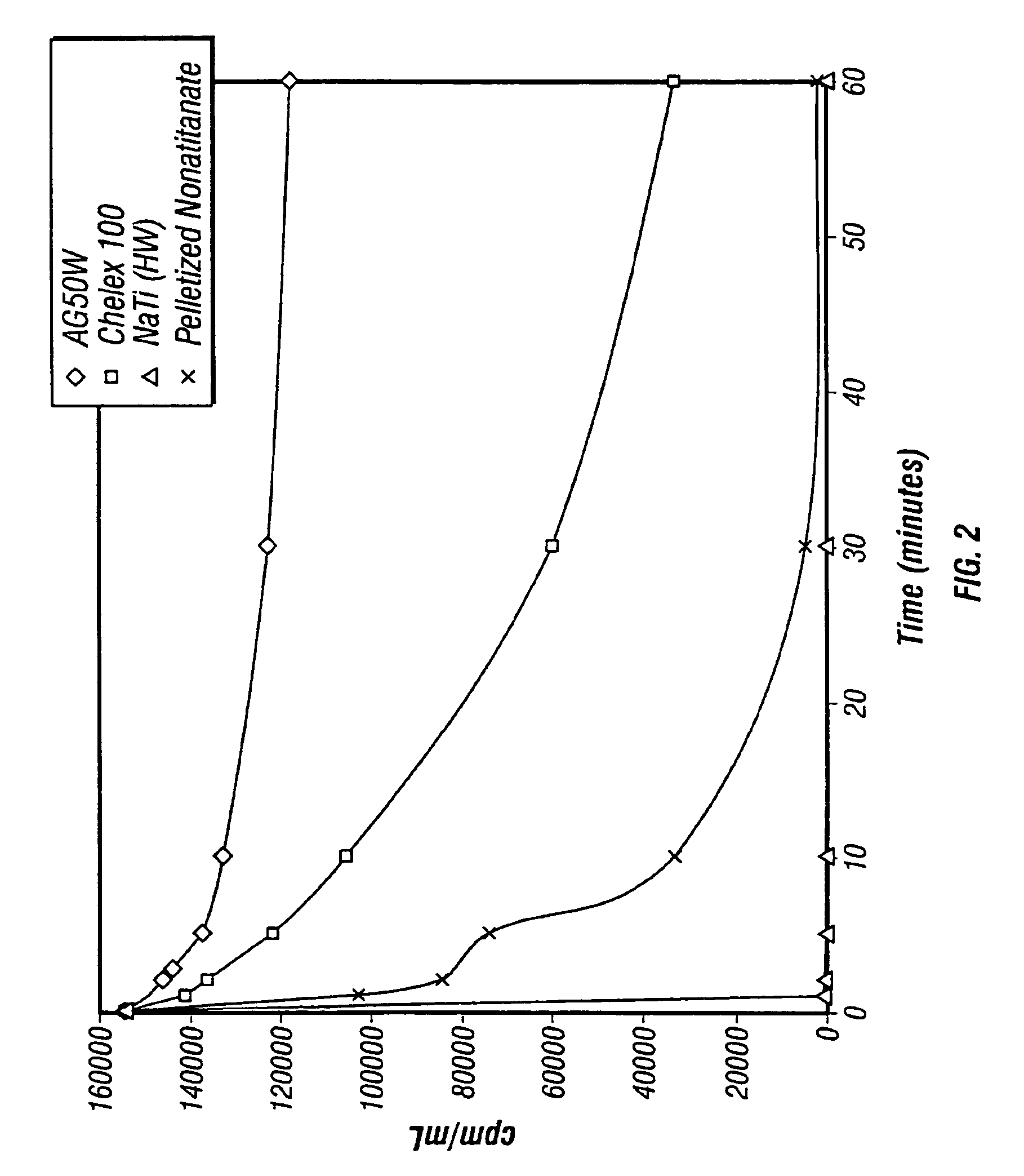Rubidium-82 generator based on sodium nonatitanate support, and improved separation methods for the recovery of strontium-82 from irradiated targets
a generator and sodium nonatitanate technology, applied in the field of selective separation of strontium82 from other radioisotopes, can solve the problems of limited life of current systems using hydrous tin oxide, relatively non-selective nature of reinforcing redox,
- Summary
- Abstract
- Description
- Claims
- Application Information
AI Technical Summary
Benefits of technology
Problems solved by technology
Method used
Image
Examples
example 1
Preparation of Sodium Nonatitanate
[0048]Sodium nonatitanate (NaTi) was synthesized hydrothermally as follows. 77.5 g of titanium isopropoxide was added to 84.35 g of a 50 wt % solution of NaOH with vigorous stirring and 60 mL of deionized water was added. The resultant gel was heated at approximately 108° C. for 3 hours, transferred to a hydrothermal pressure vessel with an additional 90 mL of deionized water, and heated at either 170° C. or 200° C. for times ranging from 21 hours to 1 week. After the allotted time, the materials were filtered, washed with ethanol to remove residual base and dried at 60° C. The mass of sodium nonatitanate produced was approximately 31 g. Each sample was characterized using x-ray powder diffraction (XRD). The reaction is outlined in Equation 1.
9 Ti(OC3H7)4+4 NaOH(aq)→Na4Ti9O20xH2O+9 C3H7OH (1)
[0049]The crystallinity of the material was shown to be dependent upon the reaction time and temperature, with the most crystalline materials being produced af...
example 2
Determination of Strontium Selectivity
[0052]Sodium nonatitanate and a variety of other ion exchange materials were obtained and evaluated for use in the separation of 82Sr from targets and in a 82Rb generator. These materials are described below in Table 1.
[0053]
TABLE 1Characteristics of Ion Exchange Materials Evaluated in this StudyMaterialSourceSample PreparationNa-ClinoptiloliteGSA Resources, AZGround topowder.AW500Aldrich (1.6 mmGround to powderPellets)Hydrous SnO2Synthesized in houseNaOH + SnCl4.Washed with aceticacid / sodium acetatebufferK+ PharmacosideriteSynthesized accordingNone. Used as(K3H(TiO)4(SiO4)3•4H2O)to literature methodsynthesizedSodium TitanosilicateSynthesized accordingNone. Used as(Na2Ti2O3SiO4•2H2O)to literature methodsynthesizedAG 50W-X8 (Na+)BioRad. Strong acidConverted to Na+(25-50 Mesh)ion exchange resin.form(for alkalinesolutions only)CHELEX 100 (Na+)BioRad. ChelatingNone. Used as(50-100 Mesh)resin withreceivediminodiaceticacid functionalitySodium Nonatita...
example 3
Rubidium Selectivity from NaCl Solutions
[0066]For an ion exchange material to be suitable for use in a 82Rb generator, it must have a very high selectivity for strontium to prevent any loss of 82Sr from the ion exchange column and release to the patient undergoing a PET scan. This property was clearly demonstrated in Example 2. It must also have a very low selectivity towards rubidium, thus allowing 82Rb to be released into solution as saline is passed through the 82Rb generator. Consequently, the rubidium selectivity of the ion exchange materials was evaluated in sodium chloride media following the procedure described in Example 2. The same procedure was followed using 86Rb to spike the solutions to give an activity of approximately 200,000 cpm / mL. Total rubidium in solution was <0.05 ppm. The distribution coefficients of the materials are shown below in Table 4.
[0067]
TABLE 4Rubidium Selectivity Data from Unbuffered Sodium Chloride Solutions1M0.1M0.01M0.001MIon Exchange MaterialNaC...
PUM
| Property | Measurement | Unit |
|---|---|---|
| temperature | aaaaa | aaaaa |
| temperature | aaaaa | aaaaa |
| molar ratio | aaaaa | aaaaa |
Abstract
Description
Claims
Application Information
 Login to View More
Login to View More - R&D
- Intellectual Property
- Life Sciences
- Materials
- Tech Scout
- Unparalleled Data Quality
- Higher Quality Content
- 60% Fewer Hallucinations
Browse by: Latest US Patents, China's latest patents, Technical Efficacy Thesaurus, Application Domain, Technology Topic, Popular Technical Reports.
© 2025 PatSnap. All rights reserved.Legal|Privacy policy|Modern Slavery Act Transparency Statement|Sitemap|About US| Contact US: help@patsnap.com



